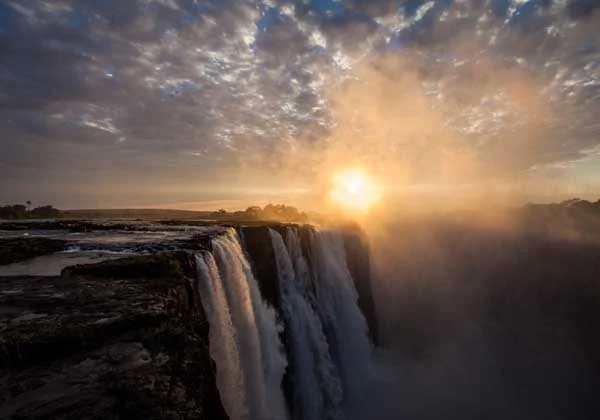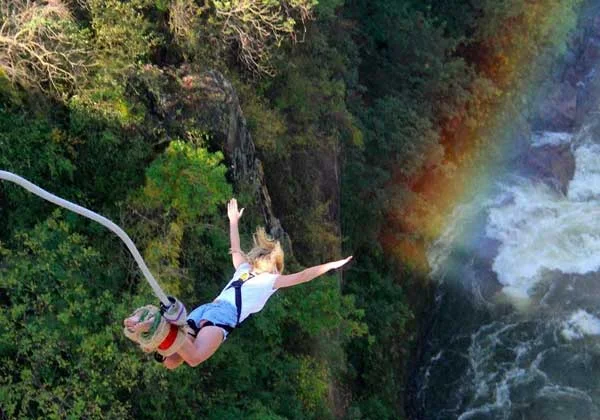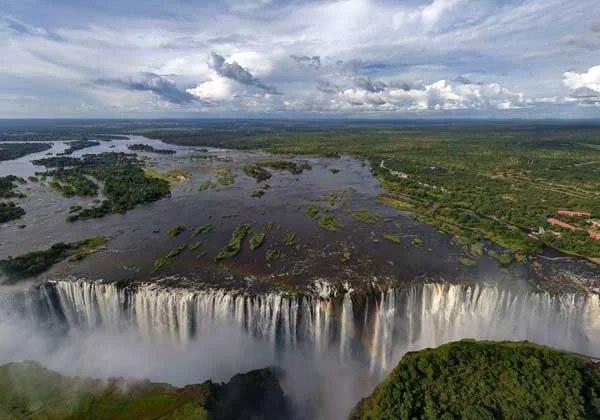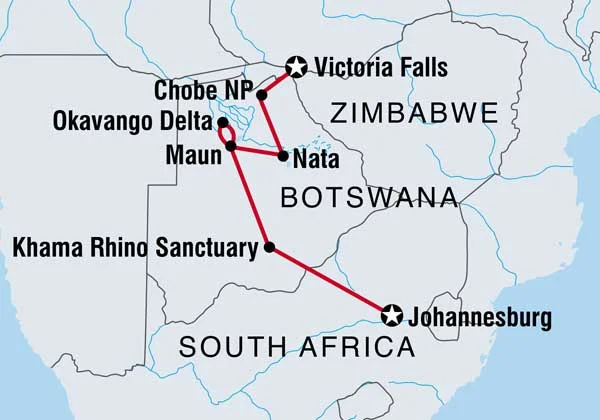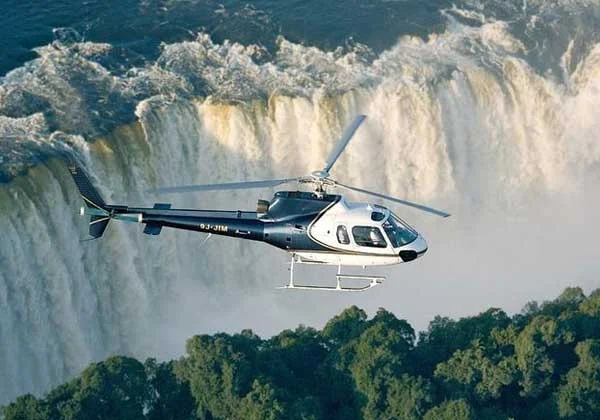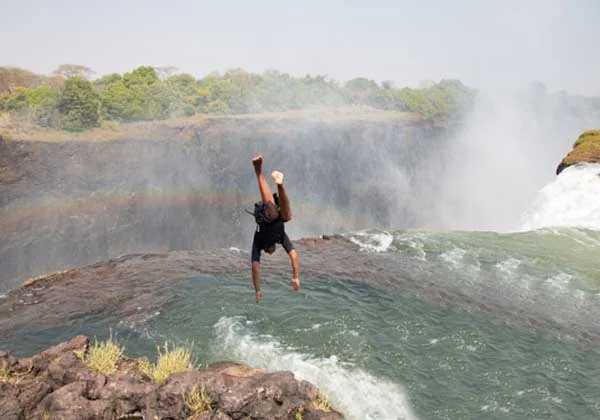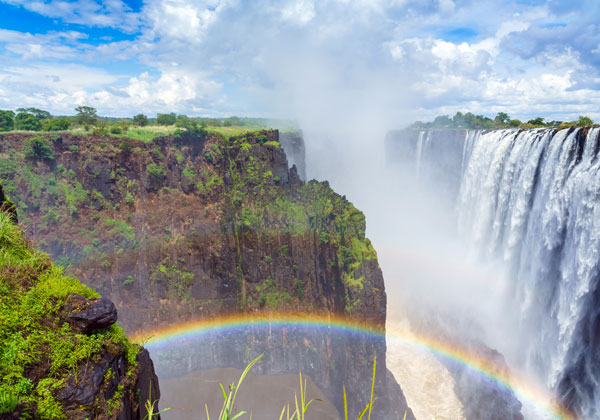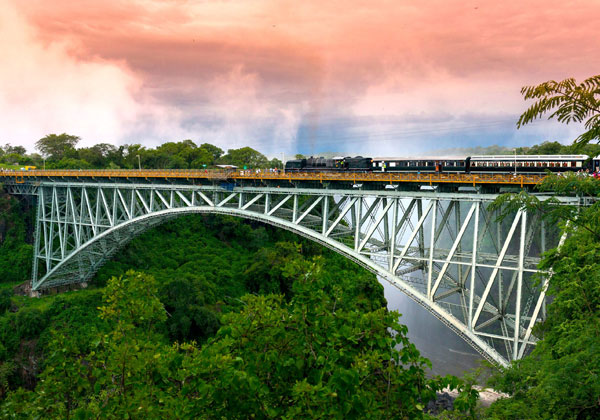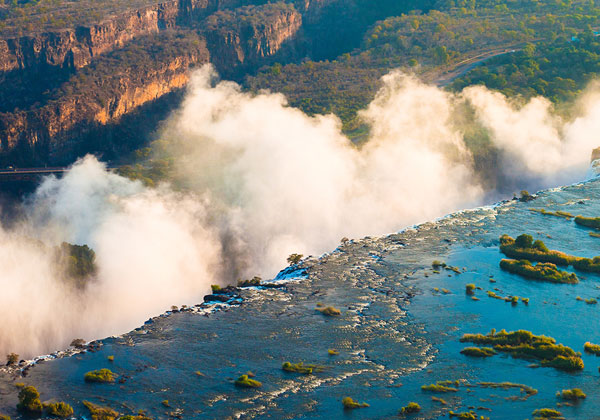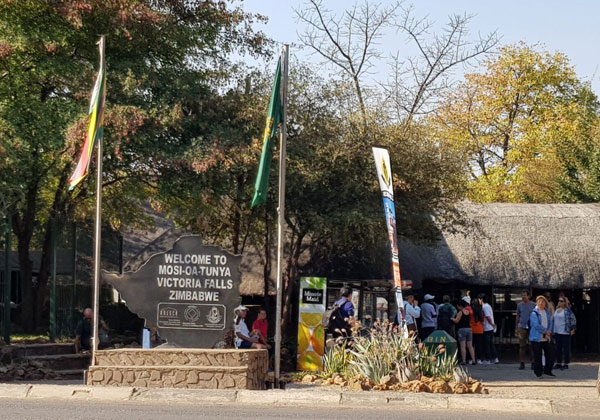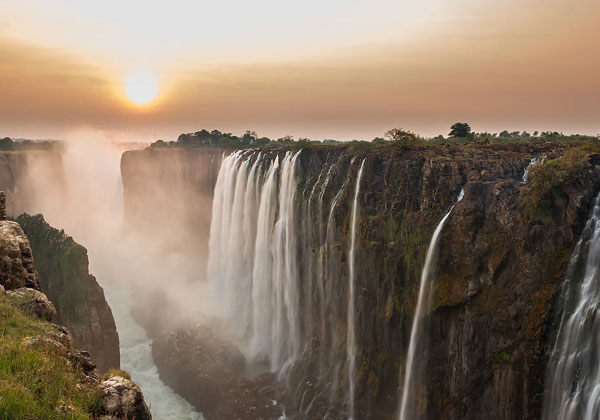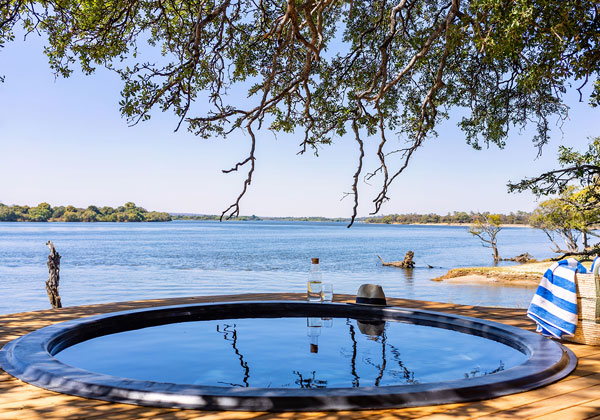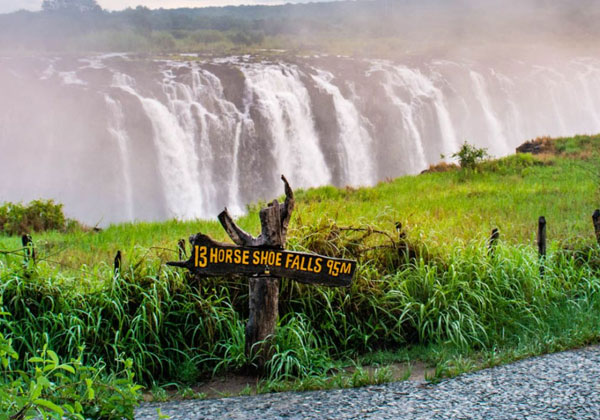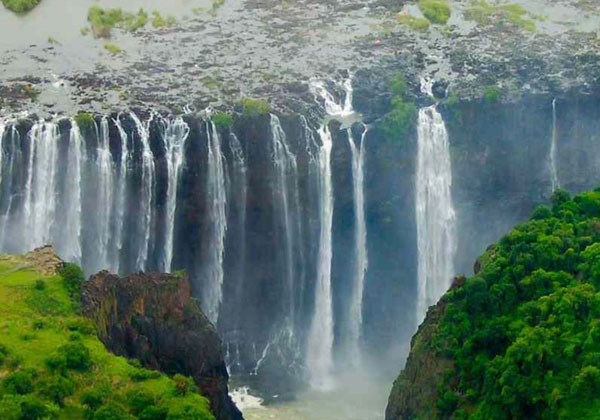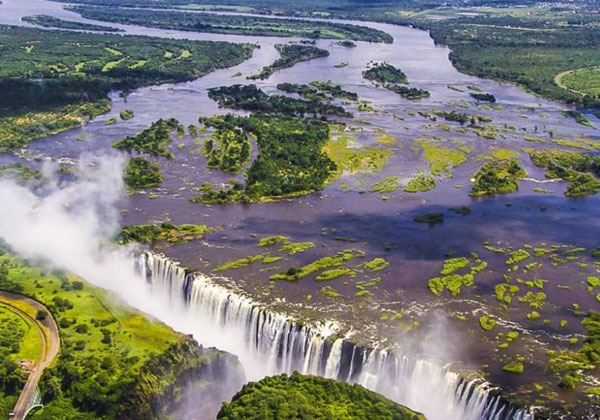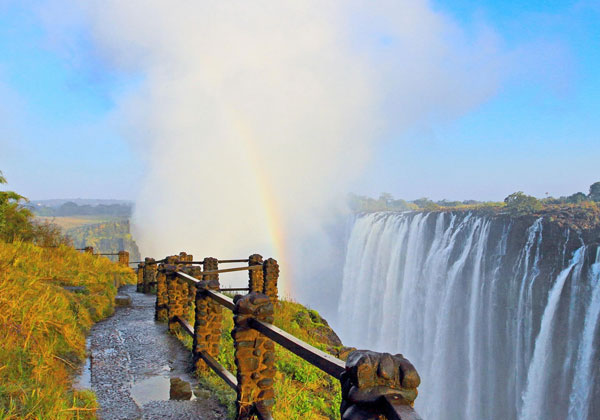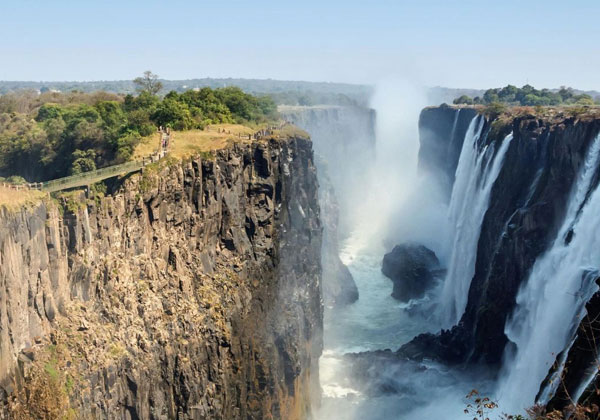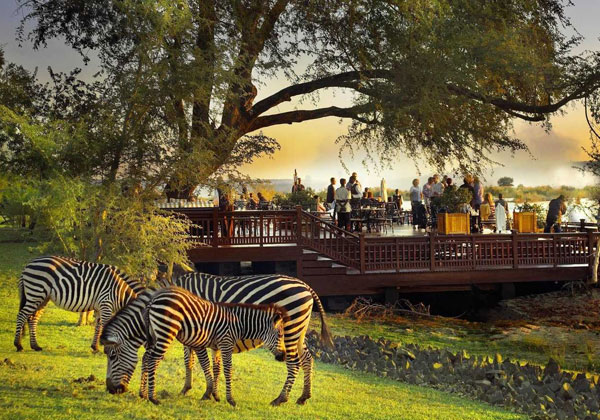Call Us
8:00am - 17:00PM
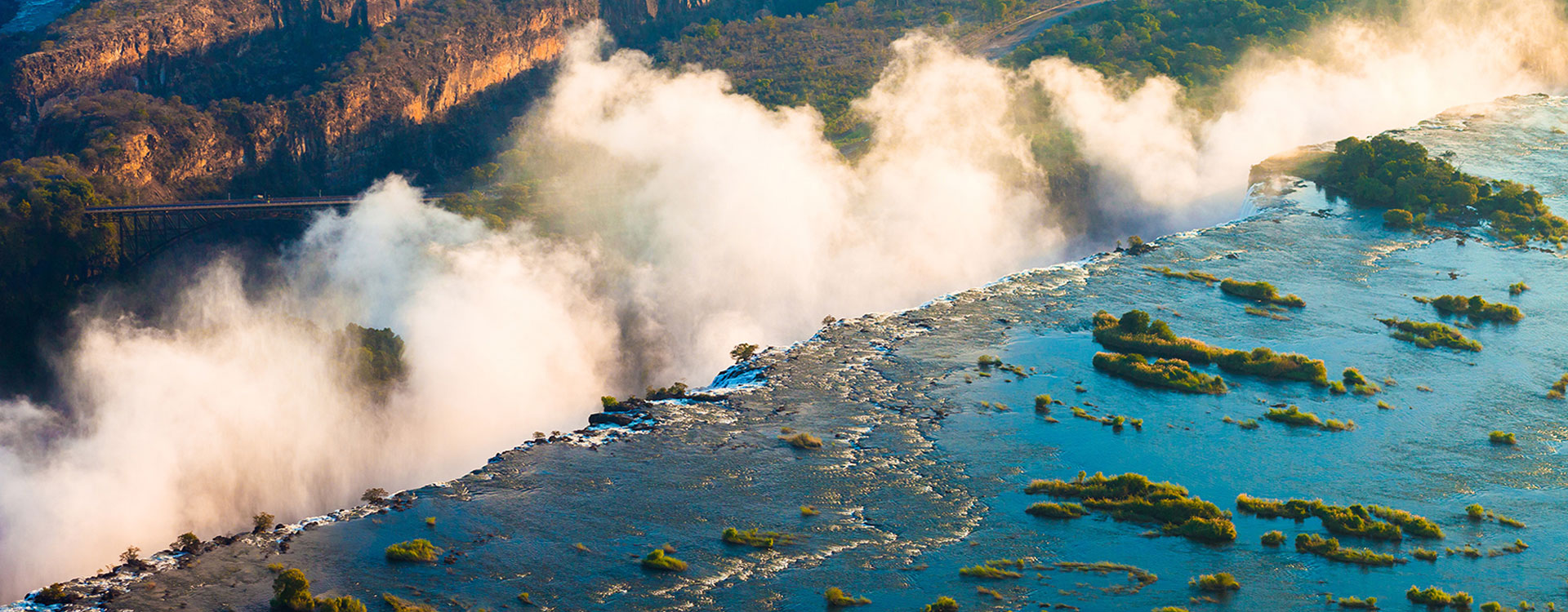
Victoria Falls Climate
Victoria Falls
Climate
The Victoria Falls Climate is truly delightful! Positioned about 900 meters above sea level in the southern African tropical belt, this Victoria Falls region boasts unique subtropical weather. Locals have simplified this climatic diversity into two main seasons, each offering its distinct atmosphere:
- Dry Season: Characterized by mild, dry winters from mid-May to mid-August, where the days are pleasant and nights can approach freezing temperatures.
- Wet Season: Dominated by hot, muggy, and rainy summers from mid-November to April, providing a lush backdrop to the falls.
The period between September and November is notably the hottest, with Victoria Falls Temperatures reaching up to 40°C (104°F), making it an exceptional time to experience the area's natural beauty. As you can see each season presents its charm, making any time a good time for Victoria Falls Tours.
About Victoria Falls Climate
Victoria Falls in Dry and Rainy Seasons
Victoria Falls Weather
The Average Daily Maximum UV Index in Victoria Falls
Average Monthly Rainfall in Victoria Falls
Average Monthly Temperature in Victoria Falls
Clouds In Victoria Falls
Victoria Falls Precipitation
Sun, Moon, Humidity in Victoria Falls
Climate Conservation
About Victoria Falls Climate
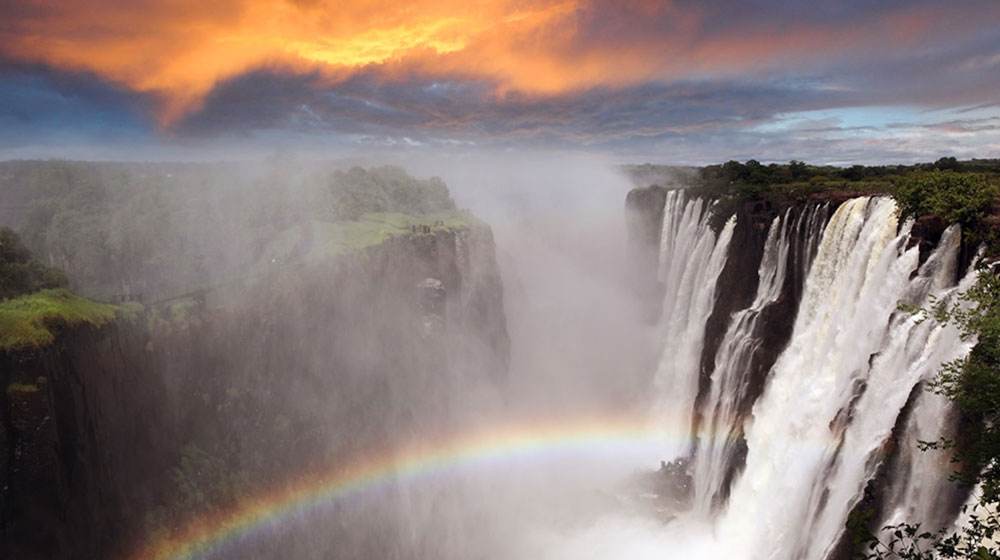
The Victoria Falls Climate is an interesting mix of subtropical elements, deeply influenced by its elevation and geographical location. This unique climate is characterized by distinct seasons that offer diverse experiences to visitors throughout the year.
Here is a detailed look into what makes this climate a marvel for travellers.
Mild, Dry Winters (May to mid-August)
Average High Temperatures - 25-27 °C (77-81°F)
Average Low Temperatures - 7-10°C (45-50°F)
During winters in Vic Falls, you will enjoy pleasant daytime weather with cold nights. Chilly nights are a refreshing contrast to the daytime warmth.
Hot, Muggy Summers (Mid–August to April)
Average High Temperatures - 32-34°C (90-93°F)
Average Low Temperatures – 15-19°C (59-66°F)
Expect hot days with high humidity, marked by frequent afternoon thunderstorms from mid-November to April.
Peak Heat (September to November)
Just before the rains, temperatures soar up to 40°C (104°F), making September to November the hottest period. Yet, this period witnesses less humidity as compared to other summer months, making it a unique time to visit Victoria Falls.
Rainfall and Sunshine
Annually, the falls receive about 690 mm (27 inches) of rain, primarily from December to February.
Despite this, the sun generously shines throughout the year, especially vividly from April to October, illuminating the falls and the surrounding Victoria Falls Rainforest.
Understanding the Victoria Falls Climate Year-Round will ensure that our guests can plan their trip to coincide with their ideal weather conditions. They will be better equipped to choose the Best Time To Visit Victoria Falls, ensuring a journey that is as climatically comfortable as visually spectacular.
Victoria Falls in Dry and Rainy Seasons
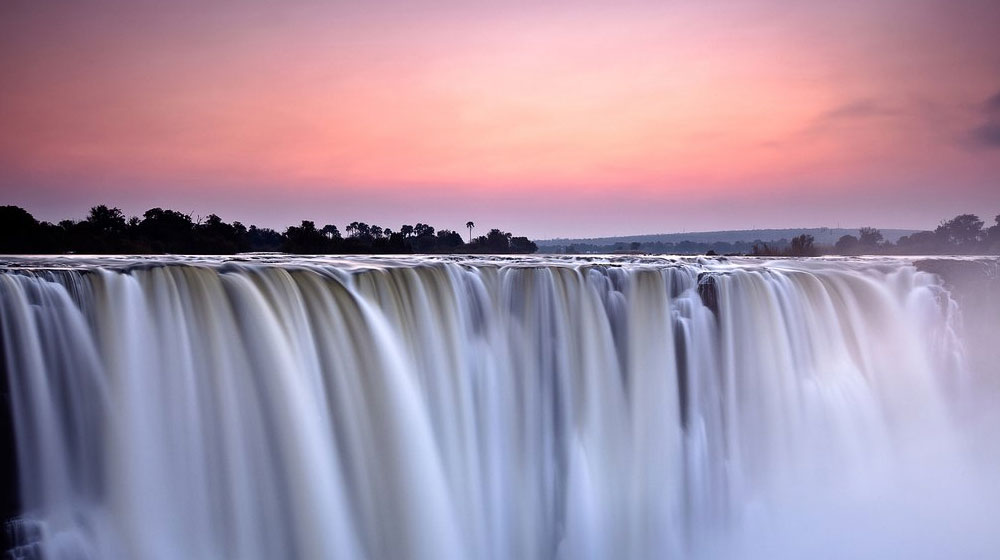
The majestic Victoria Falls transforms dramatically through the seasons. As the climate shifts, so does the spectacle and the experiences it offers. Here’s what you can expect from Victoria Falls Tours across its wet and dry seasons:
- During the dry season, the falls are less intense, allowing for clearer views and the exploration of the rainforest fed by the spray of the falls, visible from up to 50 km away.
- In contrast, the rainy season revitalizes the Zambezi River, enhancing the falls' volume and beauty but also increasing the mist and splash, which can obscure visibility.
Therefore, the Victoria Falls Climate Forecast is a crucial tool for planning your visit, whether you're aiming to witness the sheer volume of water during the high discharge season (February to May) or prefer the distinct streams and accessible rainforest during the drier months.
Victoria Falls Weather - Annual Zambezi River Water Levels
The Victoria Falls Weather plays an important role in dictating the Zambezi River's water levels. It significantly impacts the spectacle and accessibility of the falls.
Throughout the year, these water levels rise and fall in a natural rhythm that transforms the landscape. It offers an altogether different experience to visitors with each changing season.
This fluctuation of Zambezi water levels is a direct consequence of the seasonal rainfall patterns in the region and influences the Best Time to Visit Victoria Falls.
| Month | Water Level | Description |
|---|---|---|
| January | Medium/Low | A quieter period with more exposed rock faces and islands. |
| February | High | The falls begin their dramatic surge, enhancing their majesty. |
| March - April | High Peak | The highest water flow makes the falls very misty and loud. |
| May-June | High | Abundant water levels offer spectacular views with less mist. |
| July | High/Low | Transitioning as water levels start to recede, revealing more of the falls' structure. |
| August - September | Mid/Low | Lower volumes make for clearer views and photography. |
| October | Low | The lowest water levels, showcasing the geological marvels of the falls. |
| November – December | Low | Gradual increase in water level, yet remains low, offering distinct views. |
As we observe the table, we can conclude that the Victoria Falls Climate and Weather significantly influence the Zambezi River water levels.
- High water levels from February to May offer the majestic sight of the falls in full force, enveloped in a powerful mist that can obscure views but adds to the mystique.
- Conversely, the low water levels from August to December reveal the geological splendor of the falls, allowing for clearer views and the opportunity to explore the rocky basins and islands.
The Average Daily Maximum UV Index in Victoria Falls
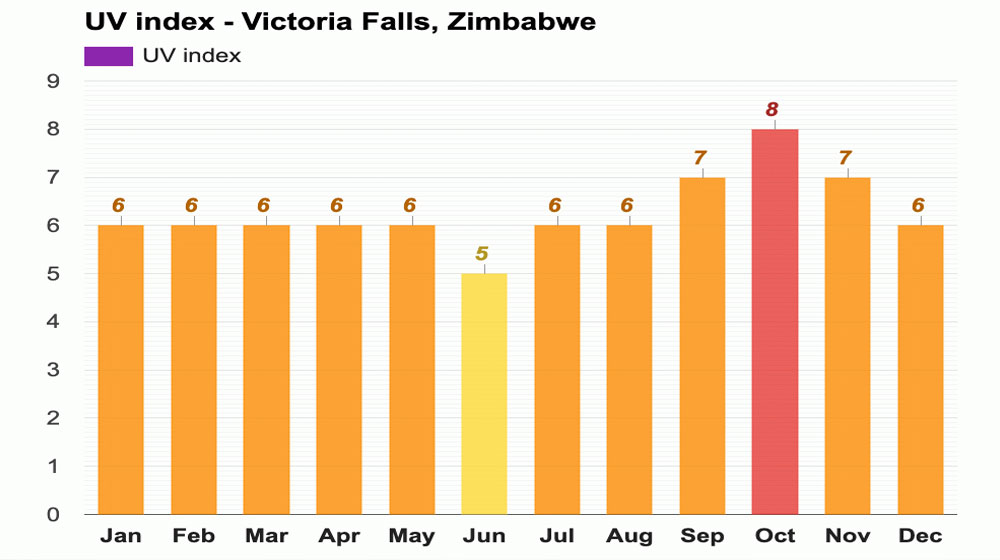
When visiting Victoria Falls, it's essential to be aware of the UV index, which is a measure of the sun's ultraviolet radiation. The Victoria Falls Climate can expose you to varying levels of UV radiation throughout the year, affecting how you should prepare for your trip.
- At Victoria Falls, the Average Daily Maximum UV Index is 6, indicating a moderate risk of harm from unprotected sun exposure.
- With an index of 6, bringing sunscreen, hats, and umbrellas is advisable on Victoria Falls Tours, especially during the hot season when UV levels can spike.
- The UV index varies, with the lowest in December and January (minimal risk) and the highest in July (greater risk). This fluctuation affects how much sun protection you'll need.
Given the Victoria Falls Climate Forecast, it's crucial to prepare for varying UV levels. During months with high UV indexes like July, extra precautions are necessary to protect against skin and eye damage.
Conversely, in December and January, when the UV index is lower, the risk is minimal, but protection is still recommended if you plan to spend extended periods outdoors.
Average Monthly Rainfall in Victoria Falls
The Victoria Falls Climate is marked by a distinct pattern of rainfall throughout the year. Annually, the region receives an average of 690 millimetres (27 inches) of rainfall, which is distributed unevenly across different months.
This variability plays a significant role in determining the Best Time To Go To Victoria Falls, affecting both the landscape and the experience of the majestic falls.
Here's a detailed look at the month-by-month breakdown of rainfall and the number of rainy days, providing insight into the Victoria Falls Climate by Month:
| Month | Rainfall (mm) | Rainfall (inches) | Rainy Days |
|---|---|---|---|
|
January |
175 |
6.9 |
16 |
|
February |
140 |
5.5 |
14 |
|
March |
80 |
3.1 |
9 |
|
April |
25 |
1 |
3 |
|
May |
5 |
0.2 |
0 |
|
June |
1 |
0 |
0 |
|
July |
0 |
0 |
0 |
|
August |
0 |
0 |
0 |
|
September |
2 |
0.1 |
0 |
|
October |
25 |
1 |
4 |
|
November |
70 |
2.8 |
11 |
|
December |
170 |
6.7 |
16 |
Key Takeaways:
- The Victoria Falls Rainfall data showcases a wet season from December to March, characterized by heavy rainfall and lush landscapes.
- This period is followed by a significant drop in precipitation from May to September, marking the dry season when the skies are clearer, and the weather is cooler.
Understanding this pattern is essential for anyone planning Victoria Falls Tours, as it impacts the falls' appearance and the region's overall weather conditions.
Average Monthly Temperature in Victoria Falls
The Victoria Falls Climate Year-Round shows different temperatures that help travellers decide when to visit. Knowing the temperature helps plan for Victoria Falls Tour Packages since it affects what you can do and see.
Here's a simple table showing the Victoria Falls Temperature each month, to help you know what to expect:
| Month | Min Temp (°C) | Max Temp (°C) | Min Temp (°F) | Max Temp (°F) |
|---|---|---|---|---|
| January | 18.8 | 29 | 66 | 84 |
| February | 18.4 | 29.5 | 65 | 85 |
| March | 17.5 | 29.8 | 63 | 86 |
| April | 14.2 | 29.2 | 57 | 85 |
| May | 10.2 | 27.8 | 50 | 82 |
| June | 7.4 | 25.3 | 45 | 77 |
| July | 6.5 | 24.6 | 44 | 76 |
| August | 9.3 | 28 | 49 | 82 |
| September | 14.1 | 32 | 57 | 90 |
| October | 18 | 33.9 | 64 | 93 |
| November | 19.2 | 32.5 | 66 | 91 |
| December | 18.8 | 30.1 | 66 | 86 |
Key Takeaways:
- In short, the Victoria Falls Climate Forecast shows it's warm to very hot all year, with October being the hottest.
- This time is the Best Time to See Victoria Falls before the rainy season starts, offering clear views but it's pretty hot.
- The cooler months from May to August are perfect for those who want to enjoy the beauty of the area without dealing with too much heat.
This info is key for anyone planning a trip with Falcon Safaris, making sure your Victoria Falls Tour is just right, matching the weather with what you want to do.
Clouds In Victoria Falls
The Victoria Falls Climate offers a dramatic sky canvas that changes with the seasons, affecting everything from photography opportunities to the backdrop of your adventure with Falcon Safaris. Here's a snapshot of what to expect:
- March to November gifts visitors with mostly clear skies, making it a prime time for Victoria Falls Tours.
- Enjoy the bluest skies in June, with clear conditions 94% of the time.
- The skies dress in grey from November to March, with cloudier days dominating, especially in January when cloud cover hits 74%.
Here's how the skies look over Victoria Falls each month:
| Month | Cloudy Skies | Clear Skies |
|---|---|---|
| January | 74% | 26% |
| February | 65% | 35% |
| March | 49% | 51% |
| April | 23% | 77% |
| May | 9% | 91% |
| June | 6% | 94% |
| July | 6% | 94% |
| August | 6% | 94% |
| September | 10% | 90% |
| October | 26% | 74% |
| November | 54% | 46% |
| December | 71% | 29% |
The Victoria Falls Climate Year-Round alternates between clear, sunny skies perfect for outdoor activities and cloudier conditions that bring a different kind of beauty to the falls.
Planning your trip for the sunnier months or opting for the moody, cloud-filled days, being aware of the Victoria Falls Weather patterns is key to ensuring you are ready for the breathtaking views that await.
Victoria Falls Precipitation
Precipitation patterns in the Victoria Falls region are greatly influenced by the distinct wet and dry seasons, which are characteristic of the Victoria Falls Climate. Understanding these patterns is important for those planning a Victoria Falls Tour. Here's an at-a-glance view of the rainfall pattern:
| Month | Average Wet Days |
|---|---|
| January | 16.5 days |
| February | 14.4 days |
| March | 9.9 days |
| April | 3.4 days |
| May to September | Nearly 0 days |
| October | 2.9 days |
| November | 8.7 days |
| December | 15.0 days |
As you can see, rainfall in Victoria Falls peaks in January, making it the wettest month. Hence, for those seeking drier adventures, the months of May through September offer nearly zero wet days, providing ideal conditions for exploring the natural beauty of the falls without the concern of rain.
So, whether you’re visiting in the wet or dry season, the weather is an integral part of the Best Time to Visit Victoria Falls.
Sun, Moon, Humidity in Victoria Falls
Exploring the Victoria Falls Climate involves not just temperature checks but also understanding the interplay of sunshine, moon phases, and humidity levels. These elements combine to create a unique weather experience for any visitor on a Victoria Falls Tour.
Sunshine
Victoria Falls enjoys generous sunlight year-round, with the most sunshine hours recorded during the dry season. Even during the rainy season, the sun makes frequent appearances between showers.
| Month | Avg. Sunshine Hours/Day |
|---|---|
| January | 7 |
| February | 7 |
| March | 8 |
| April | 9 |
| May | 10 |
| June | 9.5 |
| July | 10 |
| August | 10.5 |
| September | 10 |
| October | 9 |
| November | 7.5 |
| December | 6.5 |
Moon
The moon's presence in the sky is a constant throughout the year, with the new and full moon marking times when the night sky is especially captivating.
Here is a that chart provides a simple visual guide to important moon information for 2024.
- It shows what times the moon will be visible in the sky each day, which is represented by the hours on the vertical line and the days on the horizontal line.
- Dark grey markers show the dates and times for new moons, while blue markers show when full moons will occur.
- Next to these markers, you'll find the times when the moon rises and sets closest to these key moon phases.
Hope this information comes in handy for anyone planning a Victoria Fall Tour to catch the best lunar views.
Humidity
Humidity levels in Victoria Falls can affect comfort significantly. The muggy period extends from mid-November to early April, with January feeling the most humidity. Here’s how humidity behaves in the region:
- Humidity Levels are measured by dew point, it’s what tells you if a day feels dry or humid.
- During winter, with low humidity expect almost no muggy days at all in Victoria Falls.
- While the temperature can drop at night; if it’s been a humid day, the night is likely to feel humid too.
| Month | Muggy Days |
|---|---|
| January | 20.2 |
| February | 17.4 |
| March | 12.9 |
| April | 3.5 |
| May | 0.2 |
| June | 0.0 |
| July | 0.0 |
| August | 0.0 |
| September | 0.0 |
| October | 0.8 |
| November | 5.3 |
| December | 15.2 |
To put it all together, the Victoria Falls Climate Year-Round promises an experience enriched by ample sunlight, mystical moonlit nights, and varied humidity that shapes the texture of the days and nights.
Whether seeking the perfect sunbath or a cool evening under the stars, understanding these factors can guide you to the Best Time to Visit Victoria Falls for your preferred activities and comfort.
Climate Conservation: Sustainable Practices for Victoria Falls
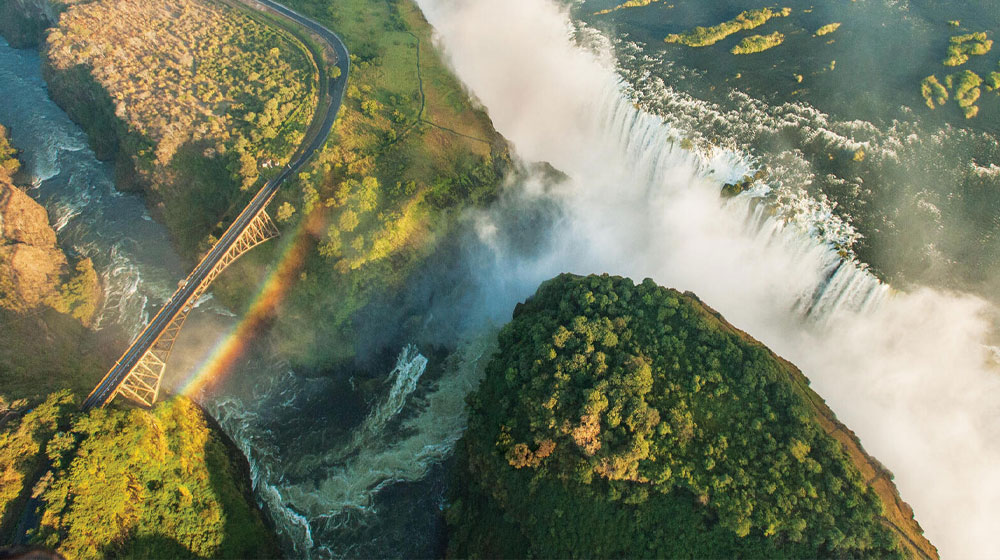
Wrapping up our journey through the diverse Victoria Falls Climate, we see a year-round canvas that awaits your exploration. Responsible enjoyment of this natural wonder is key, and that's where sustainable tourism comes into play.
Connect with us for Victoria Falls Tours which values preservation as much as adventure. Your next step towards sustainable travel starts with Falcon Safaris. Let’s make a positive impact together!
Victoria Falls
Climate
About Victoria Falls Climate
Victoria Falls in Dry and Rainy Seasons
Victoria Falls Weather
The Average Daily Maximum UV Index in Victoria Falls
Average Monthly Rainfall in Victoria Falls
Average Monthly Temperature in Victoria Falls
Clouds In Victoria Falls
Victoria Falls Precipitation
Sun, Moon, Humidity in Victoria Falls
Climate Conservation
Related Victoria Falls Travel Guide
We Think You’ll Love
Frequently Asked Questions
We Think You’ll Love
The Victoria Falls Climate is subtropical, offering warm weather year-round. Summers are hot and rainy, and winters are mild and dry. This climate creates the perfect environment for the famous misty rainbows over the falls.
The Victoria Falls Climate Year-Round is marked by two main seasons: a warm, rainy season from November to April, and a cool, dry season from May to October, making it a versatile destination for visitors.
Victoria Falls's Climate Today varies depending on the season. Currently, visitors can expect warm temperatures with occasional rainfall if it’s the wet season, or cooler, dry weather during the dry season.
Yes, it does rain in Victoria Falls, particularly from November to April, which is considered the rainy season in the Victoria Falls Climate and Weather pattern.
The Victoria Falls Climate in Winter is mild and mostly dry, making it a comfortable time for visitors to explore the area.
There are indications of climate change in Victoria Falls, with shifts in rainfall and river flow patterns being noted, which could potentially impact the region's ecosystem and tourism.
We are thrilled to help you plan your perfect safari holiday
We'd be delighted to help you with any questions you have about properties & safaris. Please fill in the form below so that we can help you create your perfect safari holiday.
Or
Contact Us
Feel free to give us a call or send us an e-mail:
Start Planning Your Tailored African Safari

Expert Safari Knowledge
With decades of expertise, we're your trusted safari guides, ensuring every moment exceeds your expectations.

Tailor-made African Safaris
Tailored to your preferences, our African Safaris guarantee an adventure perfectly suited to your desires.

Long-term Relationships
Our enduring partnerships across Africa provide exclusive access and authentic experiences.

Carefree Travel
Leave your worries behind and accept carefree travel with Falcon Safaris, where every detail is handled to perfection.
Our Travelers Say

We travelled with Falcon Safaris in Zimbabwe and Botswana for 16 days. Falcon designed a wonderful trip with private guide to the most interesting sites in both countries. The organization of the whole trip was excellent, flights within the country, accommodation and activites. The guides were very knowledgable and told us a lot about the countries, their history, people, economy and much more. We visited the Great Zimbabwe Ruins, the Victoria Falls Tour and a number of national parks in both countries.
Rhino tracking was a real adventure! We had tremendous further game drives and saw very many animals - we did the Big Five. We had much more Victoria Falls Activities than planned and enjoyed very much.We strongly recommend Falcon Safaris to everyone planning a trip to Southern Africa and East Africa.
Wonderful trip to Zimbabwe and Botswana with excellent organization and very competent guides

Our Consultant Vimbai was very helpful and accommodating. We stayed at the Elephant hills hotel which was nothing short of amazing.Our activities included a helicopter flight, dinner cruise as well as a morning game drive. All the activities were absolutely amazing.
Exceptional!

We worked with Gertrude to schedule and organize everything and she did an excellent job. I asked a lot of questions via e-mail and she answered everyone in a timely helpful manner. Our guide at Victoria Falls was also great. He met us at the airport, provided a thoughtful tour of the Falls and got us to our next guide in Botswana. Our lodgings at River View Lodge were just as described- very comfortable and excellent food. All the staff were so pleasant and helpful. If I had to do it again I would arrange a morning boat ride as well. We only did the sunset boat rides and they were the high point of our entire trip- we saw so many animals and our guide was very knowledgeable. Just a great experience. Our lodgings at Oddball's Enclave was rustic and we loved it. So great to disconnect from the world for a bit. Leo, our guide, was the best - got us out and about, saw fantastic wildlife and got back to camp safely each time. Doc manages the camp so well. This whole trip was planned and organized by Falcon Safaris and we could not have been happier.
Fabulous, well planned trip

Falcon safaris have given my the correct advice with excellent service. The only suggestion will be to work closer with the lodges to confirm bookings as soon as possible. We have booked and pay our deposit a year in advance. We have only receive our final convermation from Chobe Safari lodge a week before departure. I do realize its not within your controle but with limit alternatives and a group of 14 people it becomes an issue to find alternative accomodation if the booking was cancelled.
Excellent and efficient service
Explore Our Africa With Customize Your Tour
We love Africa's diversity and create amazing trips for you. With 30+ years of experience, we customize every trip just for you.

